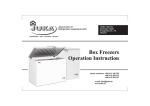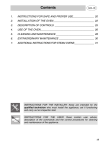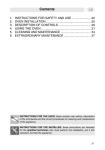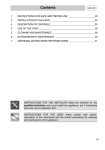Download Bauknecht HOOD Troubleshooting guide
Transcript
Instructions for use MKV 1117 Bauknecht AG, Industriestrasse 36, 5600 Lenzburg, www.bauknecht.ch Verkauf Kundendienst Ersatzteile Telefon 0848 801 002 Telefon 0848 801 001 Telefon 0848 801 005 Fax 0848 801 017 Fax 0848 801 003 Fax 0848 801 004 [email protected] [email protected] [email protected] . INDEX GB BEFORE USING THE APPLIANCE PAGE 16 INSTALLATION PAGE 17 CONNECTING THE MINI-KITCHEN PAGE 18 PRECAUTIONS AND GENERAL RECOMMENDATIONS PAGE 20 PAGE 21 USE OF THE ELECTRIC HOTPLATES PAGE 23 USE OF THE TIMER PAGE 24 CLEANING AND MAINTENANCE PAGE 25 TROUBLESHOOTING GUIDE PAGE 26 AFTER-SALES SERVICE PAGE 27 REFRIGERATOR USE OF THE REFRIGERATOR ELECTRIC HOTPLATES ADVICE Refrigerator with , compartment and automatic defrost. The rated performance is obtained with the appliance operating at ambient temperatures between +16°C and +32°C. The single appliances of the Mini-kitchen are in compliance with VDE regulations, EEC international directives, EEC directive no. 87/308/CE relating to the suppression of radio interference, and with current safety standards. The refrigerator has been tested for fluidtightness and conforms to VBG 20 accident prevention standards for cooling systems. To install an extractor hood... observe the minimum distance from the hotplates! Minimum distance between electric hotplates and lower edge of extractor hood: 650 mm. For reasons of safety this distance must absolutely be maintained! 15 BEFORE USING THE APPLIANCE In purchasing this new product you have chosen a household appliance capable of matching the highest expectations from a technical standpoint and affording an ease of use compatible with practical requirements. This new appliance offers you all that is technically possible at the time of its design and manufacture. SAFEGUARDING THE ENVIRONMENT Packing The packing material is entirely recyclable, and marked with the recycling symbol . Follow local disposal regulations. Keep the packaging materials (plastic bags, polystyrene parts, etc.) out of reach of children, as they are potentially dangerous. Your appliance is particularly economic in terms of energy consumption and therefore environment friendly, if used responsibly. If treated properly, it will give you dependable service for many years. To get the most out of your new appliance, read the user handbook thoroughly. You will find a full description of the various components. Keep this handbook for future consultation. Information: This appliance uses neither CFCs (refrigeration circuit contains R134a) nor HFCs (refrigeration circuit contains R600a - Isobutane). For more information, refer to the data plate affixed to the appliance. Important In the past, the doors of refrigerators and freezers were often equipped with spring catch or bolt type locks. If a machine of this type is to be scrapped and disposed of, destroy the lock to ensure children cannot trap themselves inside and put their lives at risk! Having unpacked the equipment, make sure no part of it has suffered damaged. Any damage must be reported to your dealer within 24 hours after taking delivery of the appliance. Wait at least two hours before connecting the appliance to the power supply in order to ensure the refrigerant circuit is fully efficient. Appliance The appliance is made from recyclable materials. If you decide to scrap the appliance, it must be disposed of in compliance with local waste disposal laws. Make the appliance unusable by cutting off the power cord. The appliance must be consigned to an authorised collection centre for the recovery of refrigerant gas. INSTRUCTIONS INSTRUCTIONS FOR USE These indications contain important information on the use of your appliance. There may be differences in detail, depending on the model. 16 INSTALLATION Before installation, make sure that the tubes on the rear of the refrigerator have not been bent in transit. If the tubes touch the refrigerator or the wall, the refrigerator will be irritatingly noisy during operation. If necessary, bend them carefully to restore the correct clearance. The Mini-kitchen must be installed in a fixed and plumb upright position. Any unevenness of the floor can be accommodated by adjusting the feet (fig. 1). Fig. 1 Warm air must be free to escape unobstructed at the rear of the refrigerator so as not to affect operation (and not to cause increased electrical power consumption). Accordingly, the ventilation slots behind the hotplates must not be covered. The machine is approved only for freestanding installation against a wall. Items of furniture may be placed adjacently on either side. 17 CONNECTING THE MINI-KITCHEN Connections to the water supply and waste pipelines should be made preferably by a professional installer. The Mini-kitchen is designed for connection to the earthed socket outlet of a 220-230 V/50 Hz supply, provided with an isolating contact in compliance with current safety regulations. The Mini-kitchen with electric hotplates must be protected by a 16 A fuse. The Mini-kitchen can be converted by a qualified installer for operation at 380-400 V 2 n 750 Hz. In this case a 10 A fuse is required. Important! In the case of a fixed electrical installation of the Mini-kitchen, the installer must fit a multi-pole switch with a gap between open contacts of at least 3 mm, or an automatic circuit breaker. This multi-pole isolating device must be fitted even if the plug is no longer accessible after the appliance has been installed. • Important for appliances operating off 380-400 V (CH) supply. The Mini-kitchen must be connected by the installer to the 380-400 V 250 Hz supply, fitting a 10 A fuse and a multi-pole switch with gap between open contacts of at least 3 mm, or an automatic circuit breaker. 18 CONNECTING THE MINI-KITCHEN For Great Britain only The wires in the mains lead are coloured in accordance with the following code: BLUE - “NEUTRAL” (“N”) BROWN - “LIVE” (“L”) GREEN AND YELLOW - “EARTH” (“E”) 1. The GREEN AND YELLOW wire must be connected to the terminal in the plug which is marked with the letter “E” or by the Earth symbol 4 or coloured green or green and yellow. 2. The BLUE wire must be connected to the terminal which is marked with the letter “N” or coloured black. 3. The BROWN wire must be connected to the terminal which is marked with the letter “L” or coloured red. Warning - this appliance must be earthed Fuse replacement If the mains lead of this appliance is fitted with a BS 1363A 13amp fused plug, to change a fuse in this type of plug use an A.S.T.A. approved fuse to BS 1362 type and proceed as follows: 1. Remove the fuse cover (A) and fuse (B). 2. Fit replacement 13A fuse into fuse cover. 3. Refit both into plug. Important: The fuse cover must be refitted when changing a fuse and if the fuse cover is lost the plug must not be used until a correct replacement is fitted. Correct replacement are identified by the colour insert or the colour embossed in words on the base of the plug. Replacement fuse covers are available from your local electrical store. Connection to a rewirable plug If the fitted plug is not suitable for your socket outlet, then it should be cut off and disposed of in order to avoid a possible shock hazard should it be inserted into a 13A socket elsewhere. A suitable alternative plug should then be fitted to the cable. For the Republic of Ireland only The information given in respect of Great Britain will frequently apply, but a third type of plug and socket is also used, the 2-pin, side earth type. In this case, the wire which is coloured GREEN AND YELLOW must be connected to the EARTH contact, and the two wires to the two pins, irrespective of colour. The supply to the socket must be fitted with a 16 amp fuse. 19 PRECAUTIONS AND GENERAL RECOMMENDATIONS • • • • • • • Use the refrigerator compartment only for storing fresh foods and the low temperature compartment only for making ice cubes, storing frozen food and freezing fresh food. Do not cover or obstruct the air vents of the appliance. Do not store liquids in glass containers in the freezer compartment - danger of bursting Do not eat ice cubes or ice lollies immediately after taking them out of the low temperature compartment - risk of “cold” burns. Do not allow children to play or hide inside the appliance - risk of becoming entrapped and suffocating. Before any cleaning or maintenance operation, unplug the appliance from the mains or disconnect the electrical power supply. The power cable can only be replaced by an authorized person. Declaration of conformity This appliance is intended to come into contact with foodstuffs and conforms to D.L. 108 of 25.01.1992 (European Directive 89/109/EEC). Information Appliances with Isobutane (R600a) Isobutane is a naturally occurring low environmental impact gas. Caution is required, however, because Isobutane is inflammable. Accordingly, it is essential to ensure that refrigerant pipelines are not damaged. Electric hotplates • • Use the appliance only in its complete state with all safety devices in place. Do not permit children to play with the hotplates. Attention! The surface of the hotplates and the cooktop become very hot during use, and small children must therefore be kept at a safe distance. • Overheated fats and oil can catch fire. Accordingly, when preparing foods such as French fries etc., do not leave pots and pans unattended. • Never under any circumstances allow food in wrapping paper or in containers of synthetic material to be placed on hotplate. Attention! In the event that other electrical appliances are plugged into sockets near the Mini-kitchen, ensure that the cables do not come into contact with the hotplates. 20 USE OF THE REFRIGERATOR The use of adaptors, sockets and extension leads is not recommended. If their utilization is indispensable, use only single adaptors or extension leads in conformity with current safety standards, making certain not to exceed the maximum current indicated on a single adaptor or an extension lead, and the maximum rated power indicated on a multiple adaptor. When the appliance is connected, the interior light switches on when the door is opened, as long as the thermostat knob is not positioned at the z symbol. After adjusting the temperature, as indicated in the next heading, the refrigerator is ready for use. Adjusting the temperature The thermostat (see figure) allows a gradual adjustment of the temperature. The z position indicates deactivation of the appliance and interior light off. For food to keep in the best condition possible, the knob should be set to position 4. For colder temperatures rotate the thermostat knob toward a higher number. Or, if the temperature is too cold, rotate the knob toward the lower numbers: position 1. Note that the thermostat settings are affected by room temperature, quantity of food in storage, position, and frequency of opening the door: with experience you will find the setting that best suits your requirements. Eggs, cheeses, dairy products: use the compartments in the door panel. Butter: use the special compartment in the door panel. Canned products: once the can has been opened, remove any residual contents and preserve in another non-metal container. Important: do not place foods or containers in direct contact with the rear part of the refrigerator compartment. Ensure free circulation of air between and around the various items. Do not cover the grilles with paper or other materials. Put cooked foods inside only when cool. Frozen foods can be stored in the or compartments for the period indicated on the package. Use of the refrigerator compartment In the compartment the temperature varies from zone to zone. The coldest zones are those close to the rear wall immediately above the crisper drawers. To maintain the aroma, substance and freshness of all foods, we suggest wrapping them in sheets of aluminium or polythene, or putting them in the special containers with lid. This avoids the mingling of smells and aromas. The space in the refrigerator can be organised in various ways by moving the grilles as appropriate. General advice on the positioning of foods: Cooked foods, hard cheeses: use the upper grilles. Meat, fish, cold meats, etc.: on the shelf of the crisper drawer. Fruit and vegetables: use the drawer provided. Drinks: use the shelf in the door panel. 21 USE OF THE REFRIGERATOR Freezing Defrosting The compartment can be operated at temperatures down to -18 °C, allowing a maximum 1.5 kg of food to be frozen in 24 hours. When freezing, the thermostat knob should be set to position 2-3. Wrap the food to be frozen in sheets of aluminium or polythene and apply labels stating the date of freezing and the contents. Take care that food already frozen does not come into contact with food waiting to be frozen. Never put hot foods into the low temperature compartment, and do not refreeze foods - even if only partially defrozen - but consume them within 24 hours. Do not place liquids in glass containers in the freezer. - Making ice cubes Pour water into the ice tray up to 2/3 full and place it in the freezer compartment. If the base of the ice trays should freeze to the compartment, do not attempt to remove with a sharp or cutting object, but use a spoon handle. Attention: Do not eat ice cubes or ice lollies immediately after taking them out of the low temperature compartment - risk of “cold” burns. Defreezing foods Some tips: Vegetables to be cooked: do not defreeze, but simply put into boiling water and cook as normal. Meat in general (large cuts): defreeze in the refrigerator compartment without removing the original packing. Before cooking, leave for a couple of hours at room temperature. (small cuts): defreeze at room temperature or cook straight away. Fish: defreeze in the refrigerator with removing the packing or cook straight away when half defrozen. Precooked foods: cook straight away in the oven as appropriate without removing from the aluminium container. Fruit: defreeze in the refrigerator. 22 If the refrigerator is not equipped with a or compartment, defrosting occurs automatically. During the defrost cycle, drops of water will run down the rear wall of the compartment. The defrost water is routed to a drain outlet and into a container on the compressor, from which it evaporates. - If the refrigerator is equipped with a or compartment, excess frost should be removed periodically to keep down electrical power consumption. Never use sharp objects or metal tools for this purpose. In any event, the compartment should be defrosted whenever the deposit reaches a thickness of 3 mm. The defrosting procedure is as follows: - unplug the appliance from the power socket; - remove food from the or compartment; - turn the thermostat knob to the z position; - as defrosting takes place, gather up the water with a sponge or a cloth; Once the compartment has defrosted completely, plug in again and set the thermostat as desired (see “Adjusting the Temperature”). Defrosting of the refrigerator compartment is automatic for this model. Note: The increase in temperature of frozen food during defrosting can shorten its storage life. USE OF THE ELECTRIC HOTPLATES Figure 3 A = Hotplates B = Knobs The normal and fast hotplates offer six nominal cooking temperatures. In the 0 position the hotplate is off. The fast hotplate, at the front, is identified by a red dot at the centre. This plate is used for quick boiling, frying, etc. For this type of use, turn the control knob to position 3. Use position 3 for quick cooking, and position 1 for slow cooking or simmering. Turn up or down as required. For braising, pot-roasting, etc., select position 3 until the fat is hot. Then put in the meat and turn down to position 2, or select a higher or lower setting as required. To cook dishes of this type more delicately, select a lower setting. Both hotplates incorporate an overheating protection system that reduces the electrical input automatically if a hazard temperature level is sensed. Position of knob Type of operation 0-6* 0-3* 0 0 off 6 3 quick cooking 5 2z browning 4 2 pot-roast 3 1 2 1 1 0z slow cooking slow cooking warming * Design of knobs dependent on the type of appliance. Using residual heat to save energy When preparing almost any type of dish, the residual heat of the hotplates can be used for the final 5-10 minutes of cooking. Accordingly, remember to select “0” in good time. The symbols on the knobs indicate the different hotplates: = knob controlling back hotplate = knob controlling front hotplate The yellow indicator remains alight as long as the hotplates are in operation. General warnings Whatever the method of cooking, use only pots and pans suitable for electric hotplates. These have special bases which conduct heat more effectively. A lid should always be used when pot-roasting, braising etc., to save energy. Also, water soluble flavours and vitamins will be lost if cooking vapours are allowed to escape freely. Abundant amounts of vapour indicate a high temperature; select a lower temperature before vapour builds up. Take care that salt does not fall onto the hotplates. An unused hotplate can rust over time as a result of the moisture absorbed by the salt. Cleaning the hotplates Wipe off spills immediately, before they can dry up. Do not scrape off dried food! Take a wet cloth and place it on the hotplate (cold) until the deposits are softened. Do not use aggressive or abrasive 23 USE OF THE TIMER Cooktop with timer (if fitted) Figure 4 B Hotplate control knob 1-6 (1-3). Each radiant hotplate hob has its own control knob. C Timer control knob. D The yellow indicator light remains on while the hotplates are in operation. Fig. 4 Turning on the hotplates Set the control knob B between 1 and 6 (1 and 3). Turn the control knob C to the right (as far as it will go). The hotplates operate when both knobs B and C are switched on. Setting the timer (Figure 5) Position of the control knob. C1 for a cooking time of around 60 minutes. C2 for a cooking time of around 30 minutes. Intermediate settings are possible. Note: If the timer counts down completely before cooking has finished, set it again. If cooking is completed before the timer has finished counting down, turn the control knob/s B to 0 to switch off the hotplate/s. The timer turns itself off automatically at the end of the set interval. 24 Fig. 5 CLEANING AND MAINTENANCE • • Clean the grilles and condenser at the rear of the refrigerator periodically, using a vacuum cleaner or brush. Clean the outside with a soft cloth. Prolonged absence 1. Empty the refrigerator. 2. Disconnect the appliance from the power supply. 3. Defrost and clean the interior. 4. When not in use, leave the door of the appliance open to prevent oxidation and the formation of mould and unpleasant odours. 5. Clean the appliance. • Clean the low temperature compartment interior (if present) during the defrosting operation. • Periodically clean the inside of the refrigerator compartment with a sponge moistened with warm water and/or neutral detergent. Rinse the interior and dry with a soft cloth. Do not use abrasives. • Clean the outside using a soft cloth moistened with water. Do not use abrasive products, scourers, stain-removers (e.g. acetone, trichloroethylene) or vinegar. 25 TROUBLESHOOTING GUIDE 1. The appliance is not working properly. • Is their a power failure? • Is the plug properly inserted into the socket outlet? • Is the isolating switch set to ON? • Has the fuse blown? • Is the power cord in perfect condition? • Is the thermostat set to z (off)? 2. The temperature in the compartments is not sufficiently cold. • Is the door shut properly? • Is food preventing the door from closing? • Is the appliance installed near a heat source? • Is the thermostat setting correct? • Are the air circulation vents blocked? 3. Temperature inside the refrigerator compartment is too low. • Is the thermostat setting correct? Fig. 6 Interior light Figure 6 To change a defective lamp, the appliance must be unplugged or isolated by means of the multi pole switch! 4. The appliance is excessively noisy. • Has the appliance been installed correctly? • Are the tubes at the back touching or vibrating? 5. Water collects at bottom of refrigerator compartment. • Is the defrost water drain blocked? (Fig. 7). 6. Excessive frost build-up in the freezer compartment. • Is the door shut properly? • Is food preventing the door from closing? Notes: • Gurgling and hissing noises due to expansion in the refrigerant circuit are normal. Fig. 7 26 AFTER-SALES SERVICE Before contacting After-Sales Service: 1. See if you can solve the problem yourself with the help of the Troubleshooting Guide. 2. Switch the appliance on again to see if the problem has been solved. If it has not, disconnect the appliance from the power supply and wait for about an hour before switching on again. 3. If the problem persists after this action, contact After-Sales Service. Specify: • a short description of the fault, • the model, • the Service number (the number after the word SERVICE on the data plate inside the appliance), • your full address, • your telephone number and area code. 27
























